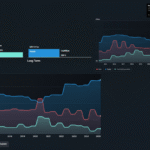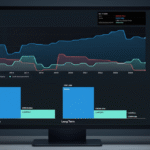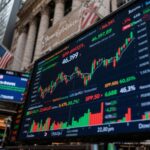When the U.S. government ground to a halt on Wednesday, conventional wisdom might have predicted market turmoil. Instead, stocks jumped, with the S&P 500 closing above 6,700 for the first time—a record high that underscores a persistent disconnect between headline concerns and market reality.
A Familiar Pattern
The government shutdown, while politically contentious, appears to be business as usual for Wall Street. Traders in prediction markets are betting the impasse will last nearly two weeks, roughly the historical average since 1990. More tellingly, Bank of America data shows the S&P 500 has historically risen an average of 1% in the week before and after shutdowns—a pattern that seems to be repeating itself.
On Wednesday, the broad-based index rose 0.34%, pushing it decisively above the 6,700 threshold. Asian markets followed suit Thursday, with South Korea’s Kospi index jumping on gains from Samsung and SK Hynix, both of which announced participation in OpenAI’s Stargate project aimed at increasing advanced memory chip production.
When Bad News Isn’t Really Bad
Perhaps more surprising than the shutdown’s muted impact was the market’s reaction to September’s dismal employment data. The ADP jobs report revealed private payrolls declined by 32,000—a stark contrast to the 45,000 increase economists had anticipated. Under normal circumstances, such a miss might trigger concern about economic health.
Yet investors seemed to embrace the weakness, viewing it through the lens of monetary policy rather than economic decline. With the Bureau of Labor Statistics’ official nonfarm payrolls report stuck in bureaucratic limbo due to the shutdown, the Federal Reserve may place additional weight on the ADP numbers. Traders are betting that weak data will prompt rate cuts in October—a silver lining that transforms negative employment news into a catalyst for continued market gains.
Tech Sector Navigates Geopolitical Waters
Beyond the shutdown and employment data, several significant developments shaped the market narrative this week. Taiwan firmly rejected a U.S. proposal to split chip production, with trade negotiator Cheng Li-chiun clarifying that the topic wasn’t even discussed during recent White House talks. The rebuff highlights ongoing tensions in the semiconductor supply chain, though it did little to dampen investor enthusiasm for tech stocks.
Meanwhile, OpenAI finalized a secondary share sale valuing the company at $500 billion, with former and current employees selling $6.6 billion in stock. The company had authorized up to $10.3 billion for sale, and the lower amount is being interpreted internally as a vote of confidence in OpenAI’s trajectory. The AI giant also announced that Samsung and SK Hynix would join its Stargate initiative, bolstering the supply of advanced memory chips critical to AI development.
The Reality Check on AI
Not all AI news was unequivocally positive. Thomas Wolf, co-founder of $4.5 billion AI startup Hugging Face, offered a sobering assessment of current AI models’ limitations. He pointed to two fundamental issues preventing products like ChatGPT from achieving scientific breakthroughs: their tendency to agree with users rather than challenge assumptions, and their design to predict the most likely next word in a sequence. True scientific innovation, Wolf noted, often comes from contrarian thinking—something today’s language models aren’t equipped to replicate.
Third Quarter Winners
Among individual stocks, several AI-related companies that had flown under the radar emerged as star performers in the third quarter, with some doubling in value. However, LSEG consensus price targets suggest these high-fliers may face downside pressure ahead, raising questions about whether recent gains are sustainable or overextended.
A Market-Specific Reality
Once again, the perception of what constitutes bad news appears starkly different for markets and outside observers. Government dysfunction, disappointing employment data, and geopolitical friction in the semiconductor industry—any of these developments might reasonably be expected to generate caution. Instead, investors continue to find reasons for optimism, whether in the prospect of easier monetary policy, ongoing AI innovation, or simply the historical precedent that shutdowns tend to be temporary inconveniences rather than lasting impediments.
Whether this resilience reflects genuine economic strength, excessive optimism, or simply the power of liquidity-driven markets remains an open question. For now, at least, Wall Street seems content to look past the headlines and focus on what it knows best: finding opportunity in uncertainty.


















